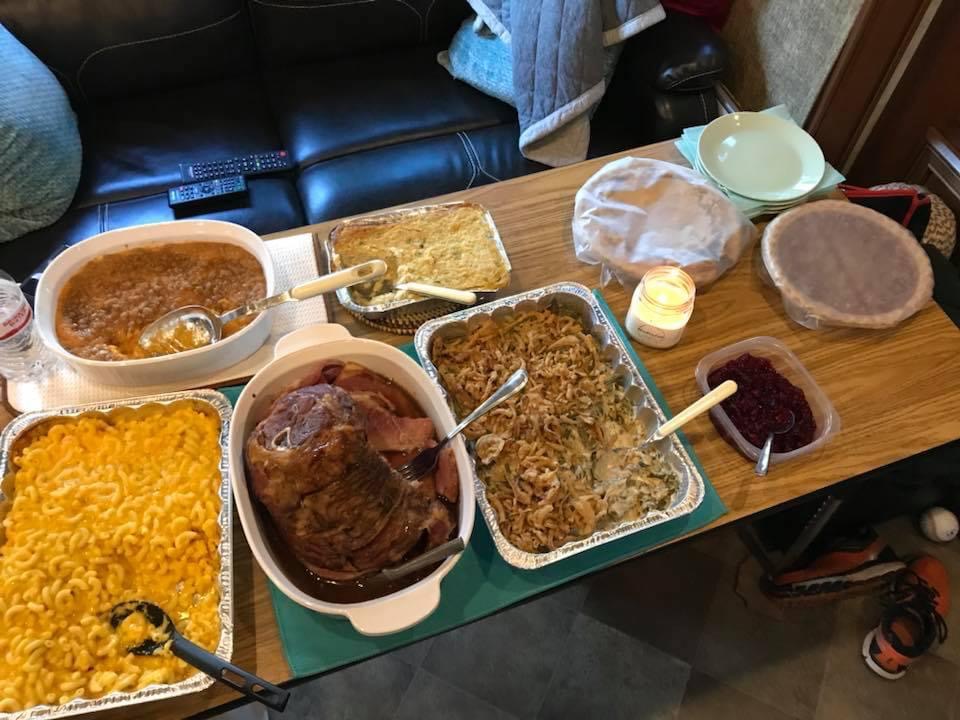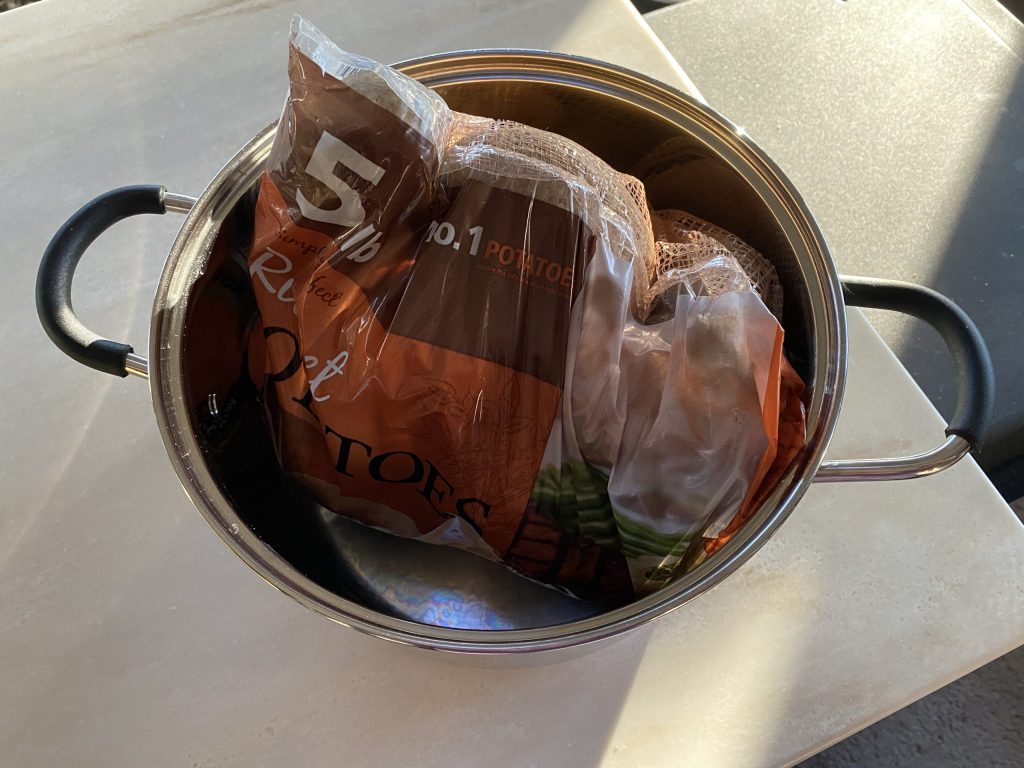
Bringing it all together, now.
- Make a reasonable plan.
- Find shortcuts.
- Spread out the work.
- Dry run.
Why is this piece so vital? Well, it is directly tied to our specific tiny kitchen challenges listed at the beginning of the guide!
The teensy, tiny countertops make it hard to prep, period. It also takes longer to prep because you can only do one thing at a time.- A limited number of small kitchen appliances, pots and pans, and casserole dishes.
- A limited amount of space to store or stockpile food.
- Storing food in a refrigerator that might not hold standard size pans. My fridge was a regular size but that definitely could be a hurdle to overcome.
Needing to eat and live and wash dishes in the tiny space while simultaneously preparing food in advance.- Reheating all of the prepared food with one small oven and a microwave.
We have covered #1 and #5, but before we can call this plan final, we need to talk about #2, 3, 4, and 6. That’s why I said this step was vital. Without it, you will only be a little prepared and I want you to knock this first try out of the park.
This dry run is going to take into consideration what you actually have to work with – in your kitchen. That isn’t something that you can copy from me. We likely have a different fridge and kitchen appliances. So here is where you are going to pull out what you do have and go from there.
Go dish by dish through your menu. Pull out your preferred recipes. List what you need to prep the dish and how you will store the dish.
Let’s use our example menu for the last time
__________________________________________
Breakfast: Coffee Cake and Coffee
Lunch: Turkey, Cranberry Sauce, Rolls, Mashed Potatoes and Brown Gravy, Macaroni and Cheese, Cornbread Dressing, Green Bean Casserole, Pumpkin Pie, and Sweet Tea.
__________________________________________
Coffee cake – Bowl and mixer, measuring cups, 9”x13” pan with lid, freezer space
Turkey – Slow cooker, cutting board, tongs, foil, freezer/fridge space
Cranberry Sauce – pot able to hold 4 cups of water easily, 2-3 c. storage container, fridge
Rolls – freezer space until Thursday, toaster oven or oven on Thursday (metal pan)
Mashed Potatoes – largest pot capable of holding 5# of potatoes, potato masher, mixer, large non-metal casserole dish with lid, reheat in microwave, store in fridge
Gravy – smallest pot or pan, whisk, bowl or other serving dish, can reheat in microwave if needed, prepared on Thursday
Macaroni and Cheese – large pot for boiling pasta, Box grater, Whisk, Measuring cups, Bowl, another 9”x13” pan (disposable) covered with foil, reheat in oven only, store in fridge
Cornbread Dressing – heat up prepared dish in oven or toaster oven (metal pan provided by store) or remove from pan to heat in microwave, fridge
Green Bean Casserole – Bowl, Box Grater, Medium size non-metal casserole dish with lid, toast topping in oven/can reheat in microwave, store in fridge
Pumpkin Pie – freezer/fridge space for crust, Mixing bowl, measuring cups, Pie plate if needed, can be stored on counter or in fridge after baking
Sweet Tea – gallon stored in fridge
*Tip* If you have 5# of potatoes and don’t know if it will fit in any of your pots, pull out your largest pot and check it.

I have made this meal a number of times so I know how far my casserole and baking dishes will go. It might frustrate you now, but if you pull out dishes to match your recipes, then you will know right away what you are lacking – before you make the macaroni and don’t have any more dishes. Before you buy a refrigerated pie crust and don’t have a pie plate to bake it in. Before you come home from the store with the turkey and don’t have space for it anywhere. Trust me!
First, check off your prep items. Do you have mixing bowls, measuring cups, a pot large enough, etc? Refer to the list you just made from your own recipes. If you don’t have a box grater and are making the macaroni and cheese, make sure you buy all your cheese pre-shredded. That’s it. Just a heads up from you to you!
Next, pull out the real dishes you will use to store all your prepped food. Make sure you have enough correct sizes of each one. Make notes of anything you need to buy or borrow. Then see how these dishes can be stacked. You will want to stack in the fridge. Better to know now if it will work. Even if your fridge is full, pull out enough food to check your 9”x13” pan will fit and if it does, is there room above it to stack another pan? This is where having lids comes in handy. A nice flat lid is ideal. Both of my casserole dishes are the French White Corningware dishes with glass lids. These won’t work for stacking unless I invert the lids. That usually works for the green beans in the medium casserole but won’t work as well for the mashed potatoes. I can do it anyway and just smooth that hole out before I reheat the mashed potatoes. Disposable pans – which I have needed to use every year are not sturdy enough to stack unless they are covered in foil and stacked “on the top”. If you are planning to use all disposable pans, consider borrowing a few “real” pans instead. Cutting boards can be placed on top of sturdy medium size pans to make a larger landing pad for a disposable dish.
Once you know for sure what pans will be used, you can breathe easy knowing when you are prepping on Wednesday that you will have all the correct pans and storage space.
Before you put the pans away, you need to try them in the oven too. If the pan is too big for your oven, make a note so you can revise the recipe by splitting it into two smaller pans (which will take longer to heat), only making ½ a recipe instead, or substituting that item. In some cases, the pan can be changed slightly by adding extra cook time. For example, the mashed potatoes can be put in a smaller pan with a back-up bowl in the fridge. The thickness will be greater, so the heat time will be longer; however, it is possible. The coffee cake *could* be made into muffins instead if you have a muffin pan; however, this will take much longer overall to prep and bake. If you find a recipe just won’t work, you have time now to replace it or ask a guest to bring it with them.
Once you are sure you have enough pans, the right equipment, fridge/freezer space, and your plan in place, the only remaining piece is how to reheat it all on Thursday! If you decide now, based on whether the pan can be heated in the oven or microwave, you will have a super easy schedule to refer to when reheating on Thanksgiving.
Things that don’t need to be heated: cranberry sauce, pumpkin pie, coffee cake, sweet tea.
Things that DO need to be reheated: Green Bean Casserole, Mashed Potatoes, Macaroni and Cheese, Cornbread Dressing, Rolls
Things that need to be finished and prepared: Turkey and Gravy
So five dishes will need to be heated. Of those five dishes, the rolls, dressing and macaroni will all be in metal disposable dishes, so they need to go in the oven or toaster oven (if you have one). The mashed potatoes and green beans can be heated in the microwave and then the topping can be toasted on the green beans for just a few minutes.
Here is my schedule for eating at 12:30
- Turkey in slow cooker at 7:30
- Gravy made and poured into a bowl anytime
- 11:00 remove turkey from the slow cooker and take off the bone, return meat to the slow cooker on warm until lunch. Leave meat in chunks. Drizzle sparingly with turkey broth if meat looks dry. Discard bones and fat.
- 11:30 put cornbread dressing in the toaster oven, bake green beans in the oven and top with fried onions until toasted
- 12:00 reheat macaroni in the oven covered, bake one pan of rolls in the toaster oven, reheat mashed potatoes in the microwave for 10 minutes or until hot
- 12:20 Reheat gravy in the microwave, put second pan of rolls in the oven if needed
- 12:30 serve your dinner!
If you want even more links + tips, here is the final post.
Wishing you and your family a very happy Thanksgiving Day from my family to yours!
[…] Don’t forget to read the last step in our plan, the dry run. This is the one step that will eliminate nearly every possible disaster – if you do this final step! […]